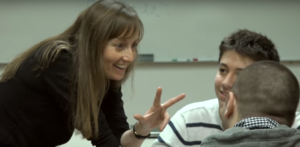Principles of good second language learning

Some pupils are taught in a language that is their second language throughout the educational pathway. They may be offered different forms of tuition. Some receive introductory tuition, others take the standard course of education with various support measures, such as second language tuition, bilingual education and/or mother tongue instruction. Some are only offered adaptation within the normal teaching activities.
By integrating the following principles when planning and implementing teaching in all subjects, the pupils will be able to work on subjects and language development simultaneously and in line with their needs.
The teachers must know their pupils well in order to give them challenges adapted to their needs and abilities. They need information about the pupils’ schooling, language skills, interests and plans. It is important to acknowledge the pupils’ experiences and resources and to base the teaching on these.
It is easiest to learn subject matter in the language you know best, and it is therefore an advantage if the pupils can receive mother tongue instruction or bilingual education. In cases where the school does not have bilingual staff, the pupils can receive support in their mother tongue in other ways. Pupils with a common language can support each other, and they can be given teaching materials and online resources in their mother tongue. The pupils’ linguistic resources can also be activated using posters and texts in different languages in the classroom, by the pupils talking about what different things are called in their mother tongue, and by giving them an opportunity to compare their mother tongue and the second language. When different languages are incorporated in the teaching, multilingual pupils are acknowledged for their knowledge and background.
- The website morsmål.no provides many multilingual resources that can be used in teaching.
It is important that the pupils are given academic and linguistic challenges even if their skills in the language of tuition are limited. There is a link between the teachers’ expectations and the pupils’ learning. The pupils can lose their motivation if the language, subject matter and exercises are too easy. Too much simplification can also mean that the pupils do not develop a language that enables them to use academic formulation. However, it is important that the pupils are given good linguistic and academic support.
It is important to ensure that the pupils understand what is expected of them, how they can get to grips with learning exercises and which goals they should strive to achieve. Teaching becomes more meaningful and motivating if the pupils understand what they are going to learn. It is an advantage that bilingual teachers translate the learning objectives so that both pupils and parents/guardians understand the purpose of the teaching.
Using manipulatives and demonstrations in teaching makes it easier for the pupils to activate their prior knowledge, and learn new concepts and subject matter. Activities and excursions are good opportunities for learning a language and subjects. Teachers should consciously work to expand the pupils’ understanding of concepts and their vocabulary by naming activities and things.
- See an example of use of manipulatives in the video Teaching in an introductory class, secondary school
Pupils can practise various verbal skills through conversation, i.e. through listening, asking questions, offering arguments and expressing opinions. Conversations with a clear academic purpose help the pupils to develop terminology in the different subjects. Explorative conversations with open questions, where the pupils are allowed a chance to participate, offer great potential for linguistic learning.
Learning to read and write in a second language
Verbal skills form the basis for reading and writing both in initial reading and writing tuition, and when learning to read and write in a new language. Pupils learning to read and write in a second language must work simultaneously on acquiring verbal and written skills, since they do not have the same basis in the spoken language as when learning to read and write in their mother tongue. Work on building up a vocabulary, on the language’s structures, and on linking sounds to letters are key aspects when pupils are going to learn the language of tuition.
Work on content and structure
Varied verbal and written activities related to a topic give pupils greater opportunity to take active part in the teaching, and can help them to achieve a deeper understanding of the subject matter. When working on subjects, it is important that the pupils become familiar with different types of texts in both written and verbal form. Pupils are helped to produce their own texts by actively using and discussing different aspects of model texts.
- See an example of work on a verbal model text in the video Introductory tuition at upper secondary level.
Work on words and concepts is important for all pupils, but particularly for those learning a second language. It is important that the teachers together take responsibility for their pupils’ language and academic development. Pupils who can work on words, concepts and language structures in all subjects and across subjects will more quickly acquire good language skills and reach academic targets.
It is important to create situations where the pupils take a conscious approach to their own learning, what learning strategies they use and when they use the different strategies.
It is important that all pupils, regardless of their language skills, are able to take part in class and school activities. This is of major importance to the pupils’ well-being, learning outcomes and language development. For example, it is important that pupils taking introductory tuition are able to participate in excursions and sports events.